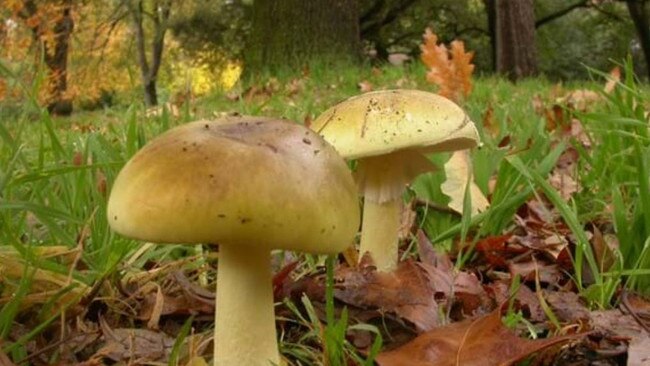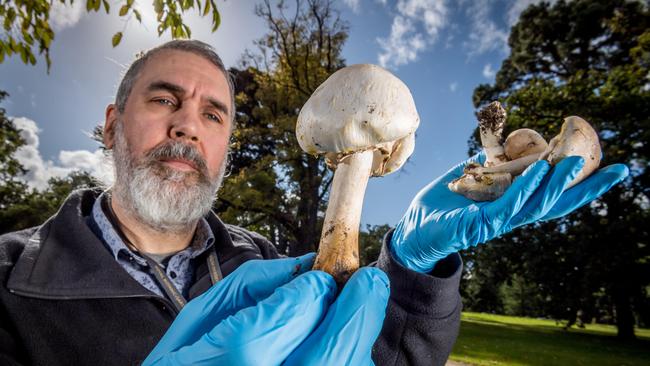Poisonous mushrooms Qld: What to look out for and how likely you are to end up in hospital
From a poisonous variety that bears a striking resemblance to ones found at the supermarket to the notorious death cap, a mushroom expert reveals what species to watch out for. YOUR QUESTIONS ANSWERED
QLD News
Don't miss out on the headlines from QLD News. Followed categories will be added to My News.
Twenty-three Queenslanders on average are hospitalised with mushroom poisoning each year, but an expert has reassured residents the death cap species involved in the deaths of three Victorians would not be responsible for any of the illnesses.
YOUR QUESTIONS ANSWERED BELOW
Between 20 and 30 Queenslanders present to hospital each year with mushroom poisoning, after likely ingesting one of two dangerous and potentially lethal varieties that grow naturally in the Sunshine State.
According to Queensland Health data, 15 patients have been admitted to hospital with mushroom poisoning so far in 2023.
There were a total of 22 emergency department (ED) presentations for mushroom poisoning during 2022 and 33 in 2021.
Mushroom expert Patrick Leonard, of the Queensland Mycological Society suspects most ED presentations were the result of two mushroom species – the green-spored parasol and yellow stainer.

“The parasol mushroom is one of the favourite mushrooms to eat in Europe particularly among Italians, and it does not occur in Australia but we have a poisonous look alike called Chlorophyllum molybdites,” he said.
“It’s sort of white with brown scales on it and brown knob on the top.
“Looking down you’d have difficulty telling the two apart, but the spores on the edible ones, they’re white and the poison one is green. People don’t check that.”
The poisonous green-spored parasol is very common in Queensland, and can be found along sidewalks and is particularly predominate in Brisbane suburbs and all South East coastal areas that experience humid weather conditions.
The toxic mushroom has been found in Far North Queensland, inland to Mount Isa and down to Toowoomba.
“If eaten, you get terrible stomach cramps and vomiting and you will go to the emergency department,” Mr Leonard said.
“It doesn’t kill you but it gives you a hell of a fright.”
The yellow stainer, or Agaricus xanthodermus, also bears a striking resemblance to mushrooms found at the supermarket.
“If you pick up that mushroom and scratch the stem with a fingernail, it turns bright yellow or you cut it in half and see bright yellow at the bottom of the stem,” Mr Leonard said.
“You find it in parks and also on the sidewalk. so people who don’t do that test and then take it home and cook them, they get quite sick.
“It also smells like phenol and it gets worse as you cook it.”

The yellow stainer has been spotted in several South East areas including the Gold Coast, Brisbane, Toowoomba, Sunshine Coast, Gympie, Hervey Bay and once in Rockhampton and is mostly found among suburban lawns, nature strips, and parks.
Queensland’s mushroom season generally runs between December and June, with 4,443 mushrooms species recorded in Queensland between 1850 and 2023.
The green-spored parasol mushroom has been spotted more than 600 times during the same period, and the yellow stainer more than 1500 times.
Mr Leonard said while there are other dangerous mushrooms present in Queensland, they are seldom seen or collected.
Another possible explanation for Queensland’s consistent toxic mushroom cases, is accidental ingestion by toddlers or small children, and parents presenting them to hospital.
A spokesman for Queensland health said Queenslanders should not pick nor eat wild mushrooms and anyone who falls ill after eating a mushroom should call triple-0 immediately.
“Eating poisonous mushrooms can make a person very ill and in some instances, have life-threatening consequences,” he said.
“It’s important to keep an eye on kids and pets when exploring the outdoors and remove any mushrooms that may be growing in home gardens.
“You should always call Triple Zero (000) if you, or someone you know, becomes ill after eating a wild mushroom.”
Those who suspect a person has eaten a wild mushroom are urged to contact the Poisons Information Centre on 13 11 26 to receive advice.




